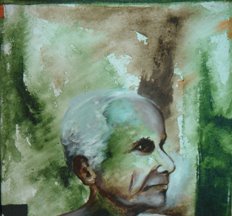
Sunday, March 29, 2009
The Sacred Tree

Saturday, March 28, 2009
How Schools Kill Creativity
World Theatre Day - International Message
Saturday, March 14, 2009
Indian Pluralism: Jai Ho!
Ram Puniyani
India’s political and cultural mosaic has been a matter of multiple volumes by social scientists. In a very simple by profound way aspects of this fascinating phenomenon of Indian society also gets reflected in most of the expressions of Indian cultural expressions, including films. The currently popular Slumdog Millionaire is no exception. The film and the aspects associated with its making display the rich cultural canvass of our society. While the critics have been talking about the film showcasing India’s poverty to the World, it being right or wrong, the other interesting aspect of the film relates to on screen and behind the screen aspects of the film of the film showing India’s plural heritage and its continuation today. The film bagged three Oscars. And they have a lot of tale to tell. All the three recipients of the Oscars have Muslim names; one of them is a Sikh (Gulzar) who has assumed Muslim name to keep him reminded of the partition carnage of 1947, which he witnessed with great anguish and pain. The second one is a born Muslim, Resul Pokkuty and third one, Alla Rakhah Rahman, was a Hindu Dilip Kumar, who changed to Islam under the influence of a Sufi saint, a Pir. When Resul accepted the award he said it is a Shiv Ratri gift for him and that he is accepting it for his country, India. Allah Rakha Rehman converted to Islam when he came in contact with a Muslim Pir, during the period of sickness of his father. Rahman is not alone in this as in India most of the Muslims converted to Islam due to the humanistic teachings of Sufi Pirs. There is a popular perception that Islam spread in India due to the threat of Muslim Kings, who came with Koran in one hand and sword in the other. The best counter to this was put by none other than Swami Vivekananda, who points out that Islam was embraced by Shudras to escape the tyranny of Landlord-Brahmin combine. There must have been many other reasons for conversions to Islam, apart from this major reason of the caste oppression, but this anyway remained the major one. A good number adopted Islam due to social interaction, like navayats in Malabar Coast in Kerala and Mewats in Rajasthan region. As such in religious tradition there are many interactive ones’. There have been Bhakti saints who had following amongst Muslims and Hindus both, and there have been Sufi Pirs who had followers amongst Hindus and Muslims in equal measure. The saints like Ram Deo Baba Pir are amongst the most popular one’s amongst the poor and low caste, cutting across the religions. Contrary to the present perceptions that Hindus and Muslims were two hostile communities, there has been a natural amity and harmony amongst the religious communities. This gets reflected in all the aspects of our social lives, be it the arena of literature, music, architecture or any other, one can clearly see the influence of each on other. The culture was hardly dictated by religion alone, within same religion there are many cultures and in most of the cultures in India one can see the influence of different religions. Many a regional aspects of the culture have been thickly intertwined. While for Ustad Bismillah Khan life was unthinkable without the river Ganges and the Kashi Temples, Munshi Premchand could think only of Urdu as the medium of his writing when he began his career as a writer. Rahi Masum Raza can write the script for the most popular Hindi mega serial Mahabharata with effortlessly, and the likes of Javed Akhtar can write the best of Bhajans for the Hindi films. Even amongst kings the enmity was not around religious issues. We see the Hindu kings in the court of Muslim kings, Raja Todarmal and Birbal being the part of Akbar’s nine jewels, while Raja Mansing being his commander in chief. Aurangzeb, supposedly the most fanatic Muslim ruler had 33% of his officials from amongst Hindus and one of his important Generals was none other than Raja Jaisingh. Shivaji, the highly revered Maratha King had Maulana Haider Ali as his confidential secretary, Siddi Sambal as his commander and Rutam-e-Jaman as his body guard-spy in chief. He was the one who built the Dargah in honor of slain Muslim King Afzal Khan, whom he had killed for political reasons. The food habits also got mixed up, beef eating which was prevalent in Vedic times, had become a taboo later, as Cow came to be revered as mother. To defer to the sentiments of Hindus, to respect the feeling of their Hindu subjects, many a Muslim Emperors advised against the killing of Cows. It’s due to all this that, Dara Shikoh, wrote a book Majma ul Bahrain, elaborating in the book that India is a vast ocean made of two seas, Hinduism and Islam. One of the highlights of 1857 rebellion against the East India company rule was the coming together of Hindus and Muslims, at the level of Kings, soldiers and peasants. It was this intercommunity unity which gave a warning signal to the British and they intensified their policy of divide and rule, introducing communal historiography, which even to the day remains as a part of social common sense. It led to those policies which encouraged communal politics in the form of Muslim League and Hindu Mahasabha-RSS. Indian pluralism has been unique in more sense than one. There has been a heavy interaction of religious communities, at the level of power (kings-Landlords), at the level of culture (Music, literature, customs, food, attire) and at the level of religion (Bhakti and Sufi traditions) It is the rise of communal politics post 1980 that the British initiated project of divisiveness has resurfaced, tried to narrow down all the politics at identity level and made the religious identities firm and deep. The fundamentalists of both religions are now looking down at the mixed traditions and pluralism, saying they are against ‘our’ religion. Slumdog while portraying the social reality, the impact of communal violence on society also highlights the deeper and most worthy interactive traditions. Tragically from last two decades the voices opposing the syncretism and plural cultural and life in India have become stronger, opposing Gazal concerts, destroying paintings, opposing those celebrating festivals like Valentine day, opposing inter-religious marriges and what have you. Hope we are at the end of the phase during which the communal politics created a hostile atmosphere against the plural ethos of our society.








